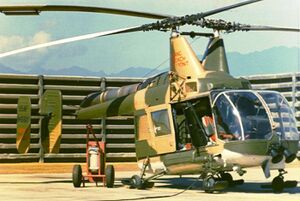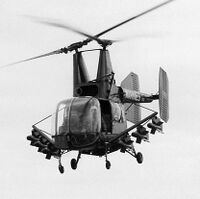Ilacatztli Ila-22: Difference between revisions
m (→Variants) |
m (→Variants) |
||
| Line 49: | Line 49: | ||
;Ila-25CB Tle | ;Ila-25CB Tle | ||
: Minesweeping helicopter | : Minesweeping helicopter | ||
;Ila-25Ix | |||
: AEW&C helicopter equipped with TZI-60AM radar which deploys underslung from the fuselage. | |||
==Service history== | ==Service history== | ||
Revision as of 18:49, 28 April 2023
| Ilacatztli Ila-22 | |
|---|---|

| |
| Search-and-rescue model of the Ila-22 | |
| Role | Anti-submarine warfare helicopter |
| National origin | |
| Manufacturer | Cuauhquetztia |
| Designer | NTT 75 |
| First flight | 24 October 1975 |
| Introduction | 1977 |
| Status | In service |
| Primary user | Zacapine Navy |
| Produced | 1977–present |
| Number built | 600 (including variants) |
| Developed into | See Variants |
The Ilacatztli Ila-22 is a military helicopter designed and developed for the Zacapine Navy by the NTT 75 design bureau. It is primarily designed for the role of a anti-submarine naval helicopter to be carried aboard various ships of the Zacapine Navy. The Ila-22 soon spawned search and rescue, minesweeping, and AEW&C radar equipped variants, as well as a civilianized model used for firefighting operations. The most striking feature of the Ila-22 are its intermeshing rotors similar to those of other Ilacatztli series synchropter designs created by NTT 75, an innovative and unorthodox design which was chosen for its potential to create a more compact helicopter well suited to naval applications. The Ila-22 and its derivatives are one of the most successful Zacapine helicopter designs of all time, remaining in service to this day as the main helicopter in naval service.
Development
The whole of the Ilacatztli synchropter initiative within design bureau NTT 75 was the brainchild of Ixhuiuh Cecihuatl, one of the first helicopter designers in the history of the Zacapine engineering establishment. By the 1970s, Cecihuatl had experimented extensively with the intermeshing rotor concept through a long series of prototypes and testbeds that comprised the early Ilacatzili project line. Cecihuatl's synchropter projects had been in phases of planning, design, prototyping and testing since the early 1950s, in between other helicopter projects she worked on such as the MIAEZ-60 tandem rotor transport helicopter. As one of the most senior designers in the bureau, Cecihuatl was well respected within NTT 75 and this had earned her a significant degree of leeway in terms of the pressure and expectations placed on her. Nevertheless, it was starting to become clear that the higherups of the NTT engineering and design program would not have much more patience for the constant prototyping and testing of the synchropter project with no service ready models in sight. Therefore, Cecihuatl gathered what resources she could lobby for and began work on the culmination of years of prototypes and rejected proposals in May of 1973. The development period of the Ilacatztli Ila-22 would be remarkably smooth, relying on the experience gained from the many preceding Ilacatztli projects for test data. It would proceed to the prototype phase in just 2 years and with a limited budget, conducting final flight tests and entering into service in July 1977 with the Zacapine Navy aboard the Motecuitlahuiani class guided missile cruisers as an ASW helicopter. Over the decades that following, the Ila-22 and its variants would become widely used across virtually all helicopter-carrying warships of the Zacapine navy, including the newest Miquimama class supercarriers.
Design
As a synchropter with a intermeshing rotor design, the Ila-22 uses its pair of counter-rotating side-by-side rotors both to achieve lift and the torque compensation normally done with a tail rotor in conventional helicopters. The trailing edge of each rotor blade was fitted with actuated flight control surfaces to regulate the ascent or descent of the craft. The rotors are powered by a single ZZ15Y turboshaft engine capable of producing 475 kW of power. The rotor layout and the powerful engine provide for exellent stability in flight and a significant lifting potential, allowing for the Ila-22 to carry a greater weight of equipment for its specialized role. The intermeshing rotor design also eliminated the need for a long tail with a tail rotor or other torque compensator, as torque would be controlled through collective pitch of the rotor sets. This would not only save the power needed for the tail rotor, it would also allow the aircraft to be smaller and more compact which would make it easier to stow in the limited interior hangar space of Zacapine Navy ships without making significant sacrifices to cargo capacity, lifting power or stability. The design would come at the cost of reduced efficiency, however, as neither rotor set would be directed straight up and would therefore have reduced efficacy in generating vertical force. It was also noted early on that the tilt of the rotors could pose a hazard to ground crews. This caused the final production model of the Ila-22 to have extended pylons to greater ground clearance of the rotors, although crews were still advised to approach the helicopter only from the front or back while the rotors were in motion for safety purposes.
The principal production model of the Ila-22 is outfitted for anti-submarine operations. It would be crewed by a pilot and navigator seating in the main cockpit, with space for a sonar operator in the compartment behind the cockpit. The opening between the two spaces was unusually small, making it difficult for larger crewmembers to fit through. The fuselage is fitted with two inflatable floats which can be engaged in the case of a water landing. As many as two dozen deployable sonobuoys are stored in an aft compartment, accessible from the sonar operator's station via a set of doors. The aft compartment can also be used to carry depth charges or air-dropped torpedoes at the cost of carrying fewer or no sonobuoys. Most models of Ila-22 are equipped with a winch system, which can be used for a variety of purposes especially in the search-and-rescue role. In its anti-submarine configuration, the Ila-22's winch is used to lower either a dipped sonar system or a magnetic anomaly detector.
Some examples of the Ila-22 would have the solenoid-fire configuration of the TCN service machinegun mounted on them for the use of a door gunner. The craft could also be armed with 6 wire-guided air-to-ground missiles. These additional armament options were put in place at the behest of the Naval Infantry, which would allow variants of the Ila-22 as the Navy's main service helicopter to serve as a light attack helicopter and transport for amphibious assaults and other Naval Infantry combat operations.
Variants
- Ila-22-Chi12
- First flight capable prototype, engine testbed
- Ila-22
- Main production model equipped for anti-submarine warfare
- Ila-22N
- Naval Infantry combat variant, armed with door guns and mountings for up to 2 wire-guided air-to-ground missiles. Flight crew of 2 including pilot and gunner, with after compartment converted into a passenger compartment for one fireteam.
- Ila-23
- Civilianized version, crew of 2 with aft compartment converted into deployment tank for water or fire retardant substances.
- Ila-23Y
- Search-and-rescue variant, equipped with clamshell doors opening up to the aft compartment which is converted to handle recovered casualties.
- Ila-25CB Tle
- Minesweeping helicopter
- Ila-25Ix
- AEW&C helicopter equipped with TZI-60AM radar which deploys underslung from the fuselage.
